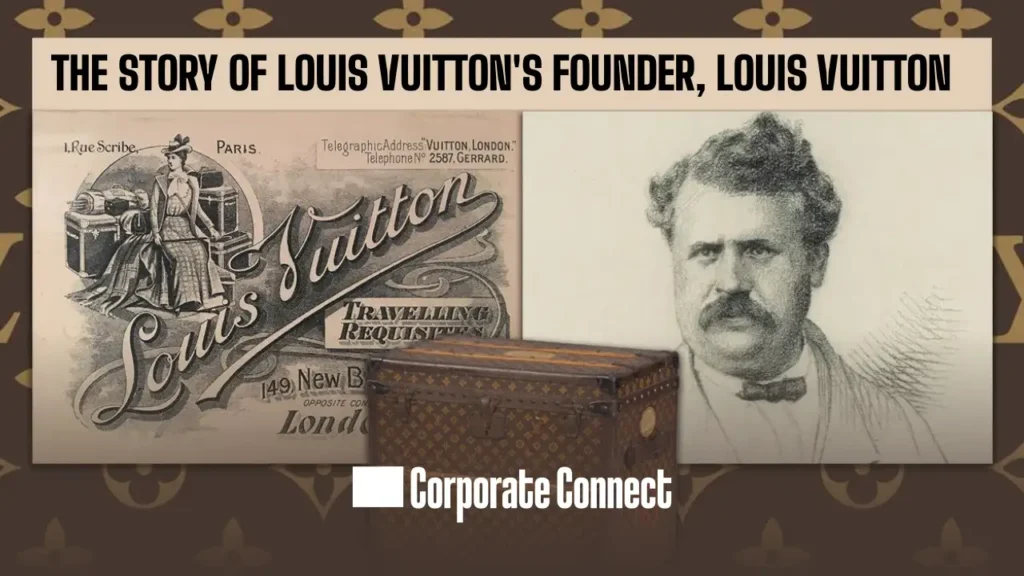The Inspiring Journey of Louis Vuitton: From Humble Beginnings to Luxury Icon
The story of Louis Vuitton’s founder, Louis Vuitton, is inspiring but not about a homeless boy. Born in 1821 in Anchay, France, Vuitton came from a poor family. At the age of 13, he left home and walked to Paris, where he began his career as a trunk maker. His journey to success wasn’t immediate, but over time, Vuitton became highly skilled in creating luggage. His big break came when he started making custom trunks for wealthy clients, which set him apart from other craftsmen.
French fashion designer and businessman Louis Vuitton was born on 4 august 1821. He founded the leather goods company Louis Vuitton in 1854, which is currently owned by LVMH. Before this, Napoleon III’s wife, Empress Eugénie de Montijo, had hired him as a trunk maker.
Vuitton’s expertise and innovative designs, such as stackable trunks, soon earned him recognition. In 1854, he opened his first store in Paris and launched the iconic Louis Vuitton brand. Through a combination of hard work, talent, and a keen understanding of the luxury market, Louis Vuitton transformed his modest beginnings into one of the most prestigious fashion houses in the world.
Although Vuitton faced many challenges, including starting with humble beginnings, he never faced homelessness during his life. His persistence and dedication to craftsmanship ultimately made him a legend in the fashion world.
Louis Vuitton’s Path to Success: A Legacy Built on Innovation and Craftsmanship
Louis Vuitton’s journey to success is one of determination and skill, rising from humble beginnings to create one of the most iconic luxury brands in the world. Born in 1821 in the small French village of Anchay, Vuitton grew up in a poor family. After his mother passed away when he was just 10 years old, his father remarried, leaving Vuitton to fend for himself. At the age of 13, with very little in the way of resources, Vuitton made the bold decision to leave his village and walk to Paris, a journey that took him two years.
In Paris, he began working as a trunk maker’s apprentice, learning the trade and developing his craftsmanship. At the time, the travel industry was rapidly growing, and Louis Vuitton recognized an opportunity to create a new type of trunk that would be both durable and stylish. Traditional trunks had rounded tops, making them difficult to stack, and were often poorly designed. Vuitton’s innovation was to create flat-topped trunks that were easier to stack and more efficient for travel.
In 1854, Vuitton’s skills and vision paid off when he opened his first store in Paris, focused on custom-made, high-quality trunks. His reputation grew, and his business attracted wealthy clientele, including royalty and the aristocracy. By the late 19th century, Vuitton’s name had become synonymous with luxury and sophistication.
Louis Vuitton also created the signature “Monogram Canvas” in 1896 to prevent counterfeiting, an innovation that has become one of the most recognizable trademarks in the luxury fashion world. Over time, the brand expanded into a global empire, moving beyond trunks into leather goods, clothing, accessories, and even partnerships with other high-fashion brands.
Vuitton’s brand and legacy lived on after his death in 1892, and it has continued to grow under the stewardship of the Vuitton family and later under the LVMH conglomerate, which acquired the company in 1987. Today, Louis Vuitton is not just a brand, but an emblem of luxury, craftsmanship, and innovation.
While the myth of Louis Vuitton being a “homeless boy” might be appealing as a rags-to-riches tale, his story is really one of resilience, vision, and entrepreneurial spirit. His early struggles didn’t define him; instead, his ability to recognize a market need and innovate helped propel him to lasting success.
Louis Vuitton’s rise to success is often portrayed as a remarkable rags-to-riches story. Born in 1821 in a poor family in rural France, Vuitton faced hardships early in life, including the death of his mother and the challenges of his father remarrying. At the age of 13, he made the daring decision to leave his hometown and travel to Paris on foot, which took him two years to complete. This bold move laid the foundation for his future success.
Once in Paris, Vuitton began working as an apprentice to a trunk maker, learning the craft that would define his career. At the time, the travel industry was booming, and Vuitton noticed that the traditional rounded-top trunks used by travelers were not efficient for stacking. He innovated by creating flat-topped trunks that were easier to stack and better suited for transportation, which quickly gained popularity among wealthy customers.
In 1854, Louis Vuitton opened his own shop in Paris, specializing in bespoke trunks. His creations became known for their craftsmanship, practicality, and high quality. In 1896, to combat counterfeiting, Vuitton introduced the now-iconic “Monogram Canvas” design, which remains a hallmark of the brand today.
Despite the myth of Vuitton being a “homeless boy,” his real story is one of resilience, entrepreneurial foresight, and skill. His early challenges did not define him; rather, it was his ability to identify a gap in the market and innovate that ultimately led him to success. The Louis Vuitton brand is now synonymous with luxury, craftsmanship, and exclusivity.
Though the narrative of Vuitton being homeless may appeal to the public’s love for inspirational stories, his true legacy is shaped by his ingenuity, determination, and business acumen.
Louis Vuitton’s story is often portrayed as an inspiring rags-to-riches journey, but there are some myths about his early life. Born in 1821 in a small village in France, Vuitton did not have a luxurious upbringing. His family was relatively poor, and after the death of his mother and the subsequent remarriage of his father, he left home at the age of 13 to pursue his dreams. This is where the myth of the “homeless boy” originates, as Vuitton traveled on foot to Paris, where he would begin to build his career.
Once in Paris, Vuitton worked as an apprentice to a well-known trunk maker, learning the craft of creating high-quality luggage. During this time, he observed the inefficiencies of the traditional rounded-top trunks used by travelers. Vuitton’s breakthrough innovation was the creation of flat-topped trunks, which were not only easier to stack but also more durable, which appealed to travelers and soon became highly sought after.
By 1854, Vuitton had opened his own workshop and began creating custom trunks for a wealthy clientele. His attention to detail and focus on quality craftsmanship set him apart in the luxury market. The brand’s most significant innovation came in 1896 with the introduction of the Monogram Canvas, designed to fight counterfeiting.
While the “homeless boy” narrative emphasizes Vuitton’s humble beginnings, his success was truly due to his inventive thinking, craftsmanship, and business acumen. His legacy has evolved into one of the most iconic luxury brands globally.
FAQ: Louis Vuitton’s Journey from Humble Beginnings to Iconic Brand
1. Who was Louis Vuitton, and what is his legacy? Louis Vuitton was a French craftsman and entrepreneur who founded the luxury brand Louis Vuitton. He is renowned for revolutionizing the luggage industry with the introduction of flat-topped trunks and innovative designs. His legacy now includes the iconic Louis Vuitton brand, which remains a leader in the global luxury market today.
2. What was Louis Vuitton’s early life like? Louis Vuitton was born in 1821 in a small village in France. Coming from a modest family, he faced significant challenges early in life. After his mother passed away and his father remarried, he left home at the age of 13 to pursue a career in Paris.
3. How did Louis Vuitton start his career? Vuitton’s journey in Paris began as an apprentice to a trunk maker. He learned the craft and eventually went on to create his own brand, designing practical, durable, and stylish luggage for the elite.
4. What was Louis Vuitton’s big breakthrough? Louis Vuitton’s major breakthrough came when he designed flat-topped trunks in contrast to the traditional rounded-top trunks of the time. These trunks were not only space-efficient but also sturdy, making them a favorite among travelers.
5. How did Louis Vuitton’s brand become successful? In 1854, Vuitton opened his own workshop, where he began producing customized luggage. His attention to detail, craftsmanship, and customer service helped him build a reputation as the go-to brand for high-quality travel gear. His Monogram Canvas, introduced in 1896, became an iconic symbol of luxury.
6. Is it true that Louis Vuitton was homeless before he succeeded? While the story of Louis Vuitton being a “homeless boy” is part of the myth surrounding his early life, it’s not entirely accurate. He did travel to Paris on foot at a young age after leaving his home, but he wasn’t homeless in the traditional sense. He worked hard as an apprentice and later built his reputation in the luxury industry.
7. How has Louis Vuitton’s brand evolved? Today, Louis Vuitton is one of the most prominent luxury brands in the world 2025, offering products ranging from fashion and accessories to luggage and perfumes. It remains synonymous with sophistication, quality, and innovation.
From humble beginnings, Louis Vuitton became a global icon, revolutionizing luxury luggage with his innovative trunks. His legacy lives on today with the renowned brand that carries his name.










